
Mixed reviews on job growth, D-day for tax time and rising food prices all played a part in how consumers felt about their finances earlier this month – and spending. New reports on consumer confidence don’t exactly show a happy-go-lucky consumer for the second month in a row and that has implications for payments, commerce and retail. Find out more.
By Jeffrey Green (@epaymentsguy)
Consumer financial optimism in March decreased for the second consecutive month, fueled by sluggish job growth, the national tax season and rising food prices, according to the Financial Optimism Index from the Consumer Bankers Association and AOL.
In March, the index dropped to -6.2, down 3.6 points from -2.6 in February. In October last year when the government shut down, the index hit -24.6. It rose to -8.8 a month later when the government reopened, peaking at +4 in January based on positive economic news.
The value of the index for each month is calculated as the percentage of respondents who are net pessimistic subtracted from the percentage of respondents who are net optimistic in that month. The index can range from +100 (all respondents optimistic) to -100 (all respondents pessimistic), with zero being the midpoint of the index’s range.
Survey questions each month are asked to a random national sample of approximately 1,600 U.S. online adults ages 18 and older in the AOL/Ipsos MediaCT Brand Tracking Survey. The index tracks optimism through agreement with four statements in a survey, and in March consumers’ aggregate responses were: